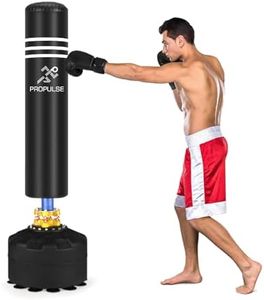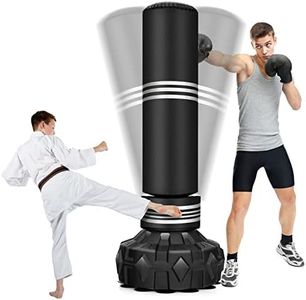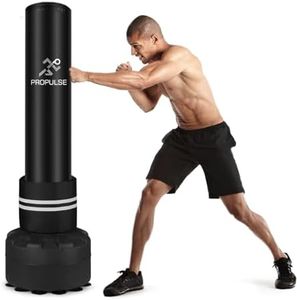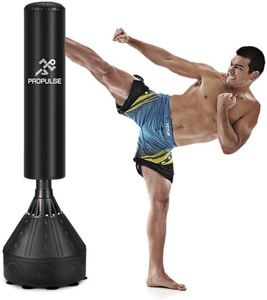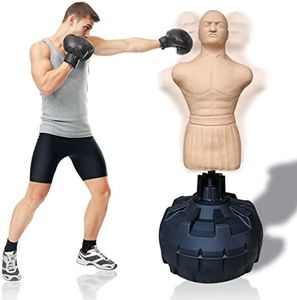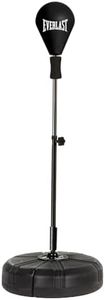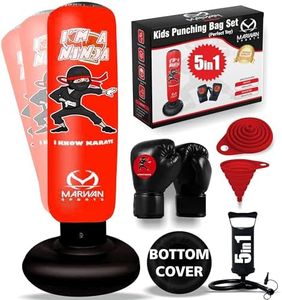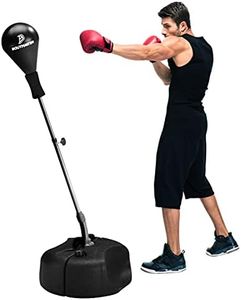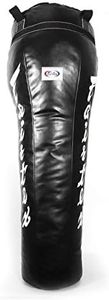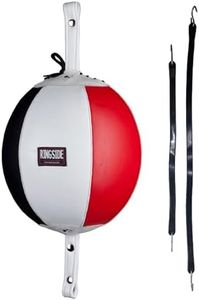We Use CookiesWe use cookies to enhance the security, performance,
functionality and for analytical and promotional activities. By continuing to browse this site you
are agreeing to our privacy policy
10 Best Punching Bags
From leading brands and best sellers available on the web.Buying Guide for the Best Punching Bags
Choosing the right punching bag can make a big difference in your workouts, whether you're into boxing, martial arts, fitness, or just want to relieve some stress. The key is to match the bag to your training goals, available space, and personal preferences. Think about what type of training you'll be doing, where you'll set up the bag, and how hard you'll be hitting it. Taking the time to consider the main features will help you find a punching bag that feels just right and supports your practice safely and effectively.Bag TypeThe type of punching bag you choose affects how you'll use it and what you'll get out of your training. Common types include heavy bags (for power and technique training), speed bags (for reflexes and hand-eye coordination), and free-standing bags (which don't need to be hung up and are more portable). To decide, consider your primary goal: do you want to develop punching power, improve speed, or be able to move the bag around? If you mainly focus on powerful strikes, a heavy bag is a great choice. For speed and rhythm, go for a speed bag. If installation is an issue, free-standing bags offer flexibility.
Bag WeightBag weight is important because it affects how much resistance and movement you'll get from the bag. Lighter bags swing and move more; heavier bags stay put and absorb more power. Punching bags generally range from 40 to over 100 pounds. Smaller or younger users, or those focusing on speed, might prefer lighter bags (40-70 pounds), while adults working on strength and power should look for bags in the 80-100+ pound range. Choose a weight that matches your strength and goals—a too-light bag may move too much, while a too-heavy bag can be tough to control or hang.
Bag LengthThe length of the bag determines how much area you have to strike, especially if you plan to incorporate kicks or knee strikes. Shorter bags (3-4 feet) are best for boxing, focusing on punches. Longer bags (5-6 feet) let you practice both punches and kicks, which is ideal for martial arts. If your workouts are mainly boxing-focused, a shorter bag is fine. For kickboxing or MMA where low strikes are common, opt for a longer bag that reaches closer to your knees or shins.
Bag Filling MaterialThe filling material inside the bag changes how it feels to hit and affects durability. Common fillings include cloth, sand, water, and foam blends. Cloth-filled bags feel softer and are easier on the hands and wrists; sand makes them much firmer and heavier, while water bags provide a more realistic punching feel and are adjustable in weight. Pick a filling based on your joint sensitivity and training style: softer fillings for beginners or frequent users, while harder fillings suit conditioned athletes looking for a tougher workout.
Cover MaterialThe outer cover of the bag determines its durability and comfort. Common cover materials are synthetic leather, genuine leather, and canvas. Synthetic leather is durable and economical, making it suitable for most users, while genuine leather is long-lasting and feels premium but needs more care. Canvas bags are sturdy but can feel rough on the hands. If you prefer a low-maintenance option, synthetic covers are practical. For a traditional, long-lasting feel, genuine leather is the choice—just expect to look after it.
Mounting and InstallationWhere and how you'll set up the punching bag is critical. Hanging bags require a sturdy ceiling or wall mount, while free-standing bags don’t need installation and can be moved easily. Think about your space and if you’re able to drill or use heavy-duty mounts—if not, free-standing bags are a great alternative. Consider the stability and accessibility: make sure your setup will be safe and convenient for regular use.
